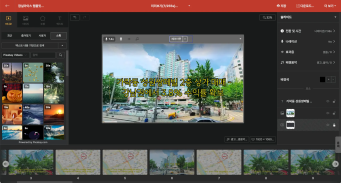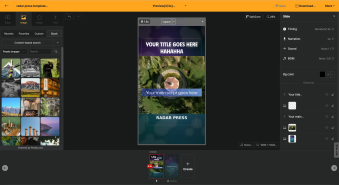
hhlee
2024-10-29 14:33:12
Behind
Developing a Global Version Website with GPT & Copilot
🗞️
[Update] Pick Up Where You Left Off – Seamless Long-Form Rendering is Here! 🚀
Until today, Videostew quietly tapped you on the shoulder when your video hit the plan’s length limit. Not anymore—say hello to the new “Project Merge” update! ...
![[Update] Pick Up Where You Left Off – Seamless Long-Form Rendering is Here! 🚀](https://cdn.videostew.com/files/thumb/323962b5e-7td8vjudu)
🗞️
[Update] Your Personal Dictionary (AI Voice Pronunciation Customization)
Your AI voice keeps butchering that one fancy word? Meet the shiny-new User Dictionary—your pronunciation fairy-godmother! 🪄Check out these real-life hacks:Got ...
![[Update] Your Personal Dictionary (AI Voice Pronunciation Customization)](https://cdn.videostew.com/files/thumb/bf4e93e99-7t74wq86j)
🗞️
[Update] Project Favorites Are Here! 🌟
Your go-to My Template just got a turbo-boost: meet Project Bookmarks! ⚡️Hit the gear icon on any project, drop it into your bookmarks bar, and boom—next time y...
![[Update] Project Favorites Are Here! 🌟](https://cdn.videostew.com/files/thumb/079dab158-7t5owv1w8)
🗞️
[Update] Projects & Library Folders: Finally, a Place for Everything!
Wave goodbye to the chaos—folders have landed to keep your projects and library assets neat, tidy, and downright respectable.Project FoldersNeed a spot for that...
![[Update] Projects & Library Folders: Finally, a Place for Everything!](https://cdn.videostew.com/files/thumb/f7774333b-7t0myy5d6)
📣
The 50-Something Real-Estate Broker’s Secret to Cranking Out Blog & YouTube Content at the Same Time (Without Losing His Mind)
These days, even real-estate agents are jumping on YouTube to showcase listings and dish out market insights through slick video content.Meet Mr. Tae-yong Ahn f...

🎓
Turn Your Script into a Video: Practical Content Repurposing Hacks
This post is your no-fluff, real-world playbook for turning the flow of your writing straight into repurposed video content. If video production has always felt...

🗞️
[Update] AI Voice Cloning Has Arrived 🎙️✨
1~3분 정도 길이의 목소리 음성 파일로 나만의 TTS를 생성할 수 있는 AI보이스 클로닝 기능이 업데이트되었습니다.AI보이스 > Custom브라우저 상에서 실시간으로 녹음하거나, 미리 녹음된 음성파일을 업로드하여 생성할 수 있습니다.워크스페이스별로 1개의 클로닝 보이스를 생성할 ...
![[Update] AI Voice Cloning Has Arrived 🎙️✨](https://cdn.videostew.com/files/thumb/29d6f68d0-7sb686t98)
🤔
The Video-Editing Sidekick That Slides Right Into Your Workflow: Where Videostew Is Headed
You just hit "publish" on your blog post, but the video keeps getting pushed to the mystical land of “later.” Sound familiar? I’ve lost count of how many market...

When developing a website, you might focus solely on your native language, but if you're offering a globally sellable SaaS service, something feels lacking. However, going all out for a global launch can be more demanding than expected. Our team has found a way to develop comfortably in our native language while also supporting global needs, as outlined below.
Translation Completed in the Editor
Drawbacks of Variable Handling
Typical i18n libraries handle multiple languages as follows. There are several methods, but the basic structure is as follows: creating a key for each message and displaying it in the user's language. At first glance, this seems like the most reasonable method.
This method represents the simplest form of running a multilingual version. It has the advantage of being able to flexibly add various languages as the business grows. However, when the business is not yet at the appropriate growth stage, and the work is done by a small development team, there are transitional issues like the ones below.
While these may seem like trivial chores, they lead to wastage of scarce development resources when working on the front-end development that touches user messages.
Embedding Language-Specific Messages in Code
To minimize these inconveniences, the Videostew team develops multilingual versions at the pace of a single native language version. Instead, they limit the multilingual version to just "English." Although this approach can't be maintained as the market expands, it is very useful in the initial global phase to appeal to the user base that can use "English."
The Videostew team registers and uses a global helper called directTrans in both the backend and frontend. The implementation of this code is very simple. It takes the native Korean message as the first parameter and the global English message as the second parameter.
The section where messages are displayed to the user can simply be created as follows:
Looking at it this way, one might think you need to code and translate into English anyway, but with Copilot, that's definitely not the case. Copilot, or Cursor AI tools, can refer to helper functions you frequently use or functions defined in open tabs and input patterns, so they understand the usage of commonly used helpers very well.
When you input Korean into directTrans('.. like below, it infers that the second parameter will be the translated English message, allowing you to create a global version of the code right in the editor.
< Type in your native Korean, and automatically translated English is added >
This approach overcomes all the disadvantages of the conventional global version development mentioned above.
As mentioned earlier, this method aims to quickly implement a global version without much effort. It's not suitable for producing more refined translation quality or multiple language versions. As the service grows, the language system needs to be updated.
Asynchronous Translation of Blogs
In addition to user messages in the code, the service involves numerous messages and texts. Fixed pages like landing pages or terms can be translated once and that's it, but it's hard to manually follow up on content like guides or blogs that are dynamically created and modified.
To address this, Videostew registers guides in the native Korean language and estimates the modified parts after a certain period, translating them into English using the GPT model on the backend. While there are various API services for translation, using LLM for translation offers advantages like those below.
When it comes to large guides (almost book-length) in practical application, it's impossible to translate the entire thing with each revision. So, we create hash keys based on paragraph content and only track and automatically translate the changed paragraphs. This type of call can be more cost-effective for large-scale translation if you use GPT's bulk call discount (though we aren't using it), or you could use a cheaper model than the frontier model.
Below is the address of this blog post available in both Korean and English. The English version is a result of GPT's automatic translation, considering the characteristics of our service.
Customer Support Response
To ensure a perfect, consistent customer experience and real-time user information integration, we use our own chatbot. If a user's information is not in their native language, we automatically append the native language to show alongside the original. When we respond in the native language, it is then translated back into the user's language for delivery.
< Questions not in the native language are auto-translated both ways >
This reduces delays due to translation and allows us to provide seamless global service.
Conclusion
I understand that many services have already adopted GPT in their development and operations. For small teams like Videostew, using AI tools like GPT can efficiently enable global service.